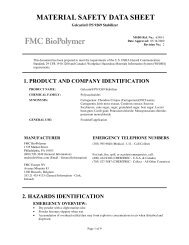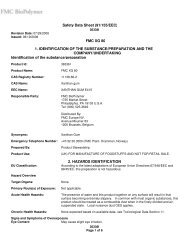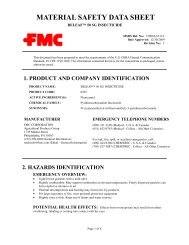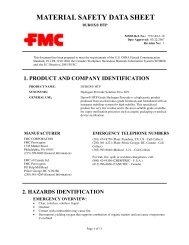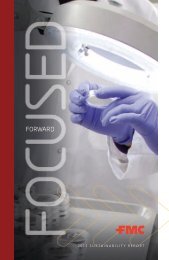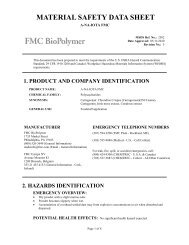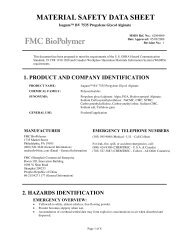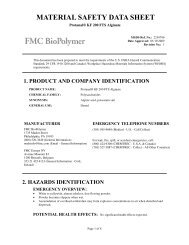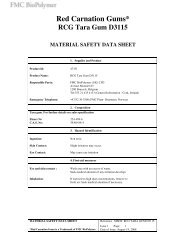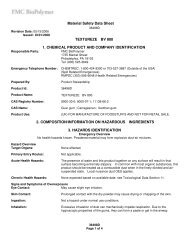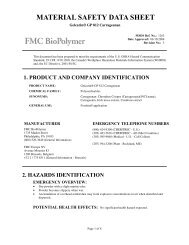MATERIAL SAFETY DATA SHEET - FMC Corporation
MATERIAL SAFETY DATA SHEET - FMC Corporation
MATERIAL SAFETY DATA SHEET - FMC Corporation
You also want an ePaper? Increase the reach of your titles
YUMPU automatically turns print PDFs into web optimized ePapers that Google loves.
<strong>MATERIAL</strong> <strong>SAFETY</strong> <strong>DATA</strong> <strong>SHEET</strong><br />
Peradigm<br />
Page 1 of 11<br />
MSDS Ref. No.: F18-55-9<br />
Date Approved: 03/11/2010<br />
Revision No.: 3<br />
This document has been prepared to meet the requirements of the U.S. OSHA Hazard Communication<br />
Standard, 29 CFR 1910.1200 and Canada’s Workplace Hazardous Materials Information System (WHMIS)<br />
requirements.<br />
1. PRODUCT AND COMPANY IDENTIFICATION<br />
PRODUCT NAME: Peradigm<br />
GENERAL USE: Non-foaming adjuvant to be used in combination with VigorOx®<br />
and Claritybranded peracetic acid products.<br />
MANUFACTURER<br />
<strong>FMC</strong> CORPORATION<br />
<strong>FMC</strong> Peroxygens<br />
1735 Market Street<br />
Philadelphia, PA 19103<br />
(215) 299-6000 (General Information)<br />
msdsinfo@fmc.com (Email - General Information)<br />
2. HAZARDS IDENTIFICATION<br />
EMERGENCY TELEPHONE NUMBERS<br />
(303) 595-9048 (Medical - U.S. - Call Collect)<br />
For leak, fire, spill, or accident emergencies, call:<br />
(800) 424-9300 (CHEMTREC - U.S.A. & Canada)<br />
EMERGENCY OVERVIEW:<br />
• Colorless liquid with a sharp, pungent, vinegar like odor.<br />
• Corrosive. Can cause severe irritation, burns and permanent damage to eyes or skin.<br />
POTENTIAL HEALTH EFFECTS: Based on the ingredients, this product is expected to<br />
be corrosive. It is also expected to be fatal if swallowed, and harmful if inhaled or in contact with skin or<br />
eyes.
Peradigm (F18-55-9) Date: 03/11/2010<br />
3. COMPOSITION / INFORMATION ON INGREDIENTS<br />
Chemical Name CAS# Wt.% EC No. EC Class<br />
Trade Secret
Peradigm (F18-55-9) Date: 03/11/2010<br />
FIRE / EXPLOSION HAZARDS: Slight fire hazard when exposed to high temperatures or<br />
flames.<br />
FIRE FIGHTING PROCEDURES: In the event of a fire, wear full protective clothing and<br />
NIOSH approved self-contained breathing apparatus. Use flooding quantities of water or chemical type<br />
extinguishers.<br />
FLAMMABLE LIMITS: Not available<br />
SENSITIVITY TO IMPACT: No data available<br />
SENSITIVITY TO STATIC DISCHARGE: No data available<br />
6. ACCIDENTAL RELEASE MEASURES<br />
RELEASE NOTES: Isolate spill or leak area, contain / recover as much of material as possible.<br />
Ventilate area before entering. Wear appropriate protective equipment. Spilled material can be absorbed<br />
with sand, earth or other inert / non-combustible material. Prevent entry into storm or sanitary sewer<br />
systems.<br />
7. HANDLING AND STORAGE<br />
HANDLING: Follow good industrial hygiene procedures when handling material. Empty drum as<br />
thoroughly as possible.<br />
STORAGE: Keep in tightly closed container, store at temperatures above 2.0°C (35°F) to avoid<br />
solidification. Avoid freezing and temperatures above 45°C (113°F).<br />
8. EXPOSURE CONTROLS / PERSONAL PROTECTION<br />
EXPOSURE LIMITS<br />
Chemical Name ACGIH OSHA Supplier<br />
Trade Secret<br />
10 ppm (TWA)<br />
15 ppm (STEL)<br />
Page 3 of 11<br />
10 ppm (PEL)<br />
ENGINEERING CONTROLS: If generation of aerosols is expected, provide mechanical<br />
local exhaust ventilation to minimize employee exposure.
Peradigm (F18-55-9) Date: 03/11/2010<br />
PERSONAL PROTECTIVE EQUIPMENT<br />
EYES AND FACE: Use cup type chemical goggles; full-face shield may be used.<br />
Maintain eye wash fountain and quick-drench facilities in work area.<br />
RESPIRATORY: For emergencies or instances where the exposure levels are not known,<br />
use a full-face positive pressure, air supplied or organic vapor respirator (U.S. NIOSH/MSHA<br />
approved).<br />
PROTECTIVE CLOTHING: Wear suitable protective clothing, such as impervious<br />
gloves, lab coat, apron or coveralls, as appropriate to protect skin.<br />
GLOVES: Use impervious gloves to protect against skin contact. Thoroughly wash the<br />
outside of gloves with soap and water prior to removal. Inspect regularly for leaks.<br />
9. PHYSICAL AND CHEMICAL PROPERTIES<br />
ODOR: Sharp, pungent, vinegar like odor<br />
APPEARANCE: Colorless liquid<br />
BOILING POINT: 110 °C (230 °F)<br />
COEFFICIENT OF OIL / WATER: Not available<br />
DENSITY / WEIGHT PER VOLUME: ~ 9.08 lb/gal. (1088 g/L)<br />
EVAPORATION RATE: Not available<br />
FLASH POINT: 63.5 °C (146 °F)<br />
FREEZING POINT: -4.77ºC (23.4ºF)<br />
MELTING POINT: Not available<br />
PERCENT VOLATILE: 79<br />
pH: 2.7 (1% solution)<br />
SOLUBILITY IN WATER: Fully miscible<br />
SPECIFIC GRAVITY: 1.0892 at 25/15.5ºC (77/60ºF)<br />
VAPOR PRESSURE: 15.5 at 20ºC (68ºF); 39.0 at 37.8ºC (100ºF)<br />
VISCOSITY: 3.33 cSt at 25ºC (77ºF)<br />
10. STABILITY AND REACTIVITY<br />
CONDITIONS TO AVOID: Temperatures below -3.9°C (25°F) to avoid<br />
solidification.<br />
STABILITY: Stable under ordinary use and storage.<br />
POLYMERIZATION: Will not occur<br />
Page 4 of 11
Peradigm (F18-55-9) Date: 03/11/2010<br />
INCOMPATIBLE <strong>MATERIAL</strong>S: Compatible with VigorOx and other <strong>FMC</strong><br />
peracetic acids. Avoid other oxidizers, acids, and<br />
all bases or alkali compounds.<br />
HAZARDOUS DECOMPOSITION PRODUCTS: Unknown; likely will burn with irritating fumes<br />
and carbon monoxide and carbon dioxide.<br />
11. TOXICOLOGICAL INFORMATION<br />
EYE EFFECTS: Expected to be severely irritating, corrosive<br />
SKIN EFFECTS: Expected to be severely irritating, corrosive<br />
DERMAL LD50: No data available for the product.<br />
Proprietary Component: 1,060 mg/kg (rabbit)<br />
ORAL LD50: No data available for the product.<br />
Proprietary Component: 3310 mg/kg (rat); 4960 mg/kg (mammal)<br />
Proprietary Component: 3000 mg/kg (rat); 5040 mg/kg (mouse)<br />
Proprietary Component: 540 mg/kg (mouse); 930 mg/kg (rat); 1700 mg/kg (rabbit)<br />
INHALATION LC50: No data available for the product.<br />
Proprietary Component: 5,620 mg/l (1 h) (mouse)<br />
TARGET ORGANS: Proprietary Component #1: Eyes, skin, respiratory system and teeth.<br />
ACUTE EFFECTS FROM OVEREXPOSURE: No data available for the product.<br />
Based on the components, this product is expected to be corrosive and contact may cause severe irritation,<br />
burns and permanent damage to the eyes and skin. Repeated exposure can cause thickening and cracking of<br />
the skin, particularly to the hands.<br />
Effects of eye contact may include stinging or burning sensations, lacrimation, redness and swelling of the<br />
eyelids, intense pain in the eyelids and eyes, ulceration of the tissues and opaqueness of the cornea causing<br />
blurred vision and loss of vision.<br />
Ingestion of this product may cause a sore throat, erosion of the dental enamel, and may have a direct<br />
irritating effect on oral mucous membranes, and may cause necrotic and ulcerative lesions. It may be<br />
irritating to the gastrointestinal tract, causing nausea, vomiting and diarrhea. Ingestion of as little as 1.0 mL<br />
of component #1 has resulted in perforation of the esophagus<br />
Breathing or inhaling this product may irritate the mouth, nose, throat, lungs, and respiratory tract, causing<br />
coughing and/or shortness of breath, and bronchitis may develop. It may also cause serious damage to the<br />
lining of the nose, throat and lungs. Higher exposures can cause build-up of fluid in the lungs (pulmonary<br />
edema).<br />
CHRONIC EFFECTS FROM OVEREXPOSURE: No data available for the<br />
product. Based on the ingredients, prolonged skin contact may cause dermatitis. Results of genotoxicity<br />
tests from the ingredients were negative.<br />
Page 5 of 11
Peradigm (F18-55-9) Date: 03/11/2010<br />
Proprietary Component #1: Repeated or prolonged exposures may cause blackening and hyperkeratosis of<br />
the skin, bronchitis and pharyngitis, erosion of exposed front teeth, and chronic inflammation of the nose<br />
throat and bronchial tubes. Chronic exposures at levels up to 200 ppm has produced palpebral edema,<br />
hypertrophy of lymph nodes and conjunctival hyperemia. Persons with pre-existing skin disorders or eye<br />
problems, or impaired respiratory function may be more susceptible to the effects of this substance.<br />
Teratogenicity testing has been reported to be negative in mice, rats, rabbits, hamsters and guinea pigs. This<br />
component has been tested and has not been shown to cause cancer, or to have reproductive effects.<br />
Proprietary Component #2: Chronic or heavy ingestion may cause tooth enamel erosion. Large oral doses<br />
may cause severe metabolic acidosis, hyperkalemia, hypotension and tachycardia. This component was not<br />
mutagenic in Salmonella typhimurium in the presence or absence of metabolic activation, and it did not<br />
induce chromosome aberrations in cultured Chinese hamster fibroblast cells; nor was it not shown to be a<br />
reproductive hazard in animals. Rats fed 1.2% for 90 weeks experienced no harmful effects on growth,<br />
reproduction, blood values, pathology or calcium levels, and slight dental attrition was seen. The actual<br />
human reproductive hazard is unknown, but it is not expected to be significant as it is a normal metabolite.<br />
No teratogenic effect was observed among the offspring of mice, rats, hamsters, or rabbits treated with<br />
large doses during pregnancy. This component is not expected to be genotoxic at physiological<br />
concentrations because it is a normal metabolite<br />
Proprietary Component #3: Ingestion of sizable amounts can cause a syndrome evidenced by abdominal<br />
pain, vomiting, increased respiration and mental disturbances. Fatalities resulting from respiratory or<br />
cardiovascular failure are known. Mean lethal adult ingestion dose is between 20 and 30 grams. When<br />
given to pregnant rats and rabbits at high doses, increased congenital malformations occurred, primarily<br />
involving the skeleton and central nervous system. This component, an NSAID, may play a role in at least<br />
one type of female infertility. Prostaglandin inhibition appears to increase the incidence of luteinized<br />
unruptured follicle syndrome, a condition in which normal ovarian follicular development is followed by an<br />
elevation of serum progesterone compatible with ovulation, but the cycle remains anovulatory because the<br />
follicular wall remains unruptured. Animal and human oral data suggests that the reduced clearance by<br />
neonates may result in drug accumulation and toxic effects when repeated oral exposures are small.<br />
Because of these concerns, the WHO Working Group on Human Lactation classified this component as<br />
unsafe for use by nursing women.<br />
CARCINOGENICITY:<br />
NTP: Not listed<br />
IARC: Not listed<br />
OSHA: Not listed<br />
OTHER: ACGIH: Not listed<br />
12. ECOLOGICAL INFORMATION<br />
ENVIRONMENTAL <strong>DATA</strong>: No data available.<br />
ECOTOXICOLOGICAL INFORMATION: No data available for the product.<br />
Proprietary Component #1<br />
96-hour LC50 = 88 mg/L (Pimephales promelas)<br />
96-hour LC50 = 75 mg/L (Lepomis macrochirus)<br />
72 to 96-hour LC50 = 88 mg/L (Fathead minnows)<br />
Page 6 of 11
Peradigm (F18-55-9) Date: 03/11/2010<br />
48-hour LC50 = 92 mg/L (Fathead minnows)<br />
24-hour LC50 = 122 mg/L (Fathead minnows)<br />
1-hour LC50 > 315 mg/L (Fathead minnows)<br />
24-hour EC50 = 95 mg/L (Daphna magna)<br />
96-hour TLm = 75 mg/L (Bluegill)<br />
24 to 96-hour TLm = 251 mg/L (Mosquito fish)<br />
24-hour TLm = 100 - 1000 mg/L (Lepomis macrochirus)<br />
24-hour TLm = 47 mg/L (Daphnia magna)<br />
Proprietary Component #3<br />
96-hour LC50 = 1370 mg/L (flow through) (Fathead minnow)<br />
13. DISPOSAL CONSIDERATIONS<br />
DISPOSAL METHOD: None of the components of this formulation are specifically listed as a<br />
"Hazardous Waste" in the Federal Regulations. Waste material should be managed in an appropriate and<br />
approved waste disposal facility. Processing, use or contamination of this product could change the waste<br />
management options. Dispose of container and unused material in accordance with federal, state and local<br />
requirements.<br />
14. TRANSPORT INFORMATION<br />
U.S. DEPARTMENT OF TRANSPORTATION (DOT)<br />
PACKAGING TYPE: Non-Bulk<br />
PROPER SHIPPING NAME: Acetic acid solution, not less than 50% but<br />
not more than 80%, by mass<br />
PRIMARY HAZARD CLASS / DIVISION: 8<br />
UN/NA NUMBER: UN 2790<br />
PACKING GROUP: II<br />
LABEL(S): Corrosive<br />
PLACARD(S): Corrosive<br />
MARKING(S): Acetic acid solution, not less than 50% but<br />
not more than 80% by mass, UN 2790<br />
ERG NUMBER: 154<br />
INTERNATIONAL MARITIME DANGEROUS GOODS (IMDG)<br />
PROPER SHIPPING NAME: Acetic acid solution, not less than 50% but<br />
not more than 80%, by mass<br />
PRIMARY HAZARD CLASS / DIVISION: 8<br />
Page 7 of 11
Peradigm (F18-55-9) Date: 03/11/2010<br />
UN/NA NUMBER: UN 2790<br />
PACKING GROUP: II<br />
LABEL(S): 8<br />
PLACARD(S): 8<br />
ADDITIONAL INFORMATION: EmS Number: F-A, S-B<br />
INTERNATIONAL CIVIL AVIATION ORGANIZATION (ICAO) /<br />
INTERNATIONAL AIR TRANSPORT ASSOCIATION (IATA)<br />
ADDITIONAL INFORMATION: NOTE: Venting of packages is not<br />
permitted for air transport.<br />
15. REGULATORY INFORMATION<br />
UNITED STATES<br />
SARA TITLE III (SUPERFUND AMENDMENTS AND REAUTHORIZATION ACT)<br />
SECTION 302 EXTREMELY HAZARDOUS SUBSTANCES (40 CFR 355, APPENDIX A):<br />
None of the components are listed.<br />
SECTION 311 HAZARD CATEGORIES (40 CFR 370):<br />
Immediate, Delayed, Fire<br />
SECTION 312 THRESHOLD PLANNING QUANTITY (40 CFR 370):<br />
The Threshold Planning Quantity (TPQ) for this product, if treated as a mixture, is 10,000 lbs;<br />
however, this product contains the following ingredients with a TPQ of less than 10,000 lbs.:<br />
None<br />
SECTION 313 REPORTABLE INGREDIENTS (40 CFR 372):<br />
Not listed<br />
CERCLA (COMPREHENSIVE ENVIRONMENTAL RESPONSE COMPENSATION AND<br />
LIABILITY ACT)<br />
CERCLA DESIGNATION & REPORTABLE QUANTITIES (RQ) (40 CFR 302.4):<br />
Proprietary Component #1<br />
5,000 lb<br />
TSCA (TOXIC SUBSTANCE CONTROL ACT)<br />
TSCA INVENTORY STATUS (40 CFR 710):<br />
All components are listed or exempt.<br />
Page 8 of 11
Peradigm (F18-55-9) Date: 03/11/2010<br />
RESOURCE CONSERVATION AND RECOVERY ACT (RCRA)<br />
RCRA IDENTIFICATION OF HAZARDOUS WASTE (40 CFR 261):<br />
Waste Number: Not considered a hazardous waste.<br />
CANADA<br />
WHMIS (WORKPLACE HAZARDOUS <strong>MATERIAL</strong>S INFORMATION SYSTEM):<br />
This product has been classified in accordance with the hazard criteria of the Controlled Products<br />
Regulations and the MSDS contains all the information required by the Controlled Products<br />
Regulations.<br />
Hazard Classification / Division: B3<br />
D2A<br />
E<br />
Ingredient Disclosure List: Proprietary Component #1<br />
Proprietary Component #2<br />
Domestic Substance List: All components are listed or exempt.<br />
INTERNATIONAL LISTINGS<br />
Proprietary Component #1<br />
Australia (AICS): Listed<br />
China: Listed<br />
Japan (ENCS): (2)-688<br />
Korea: KE-00013<br />
Philippines (PICCS): Listed<br />
Proprietary Component #2<br />
Australia (AICS): Listed<br />
China: Listed<br />
Japan (ENCS): (2)-1318<br />
Korea: KE-20831<br />
Philippines (PICCS): Listed<br />
Proprietary Component #3<br />
Australia (AICS): Listed<br />
China: Listed<br />
Japan (ENCS): (3)-1639); (9)-1094<br />
Korea: KE-20384<br />
Philippines (PICCS): Listed<br />
COMMENTS:<br />
Proprietary Component #1<br />
Korea Toxic Release: >=1.0% (by weight)<br />
Japan-GHS Acute Hazards to the Aquatic Environment: Category III (harmful to aquatic life)<br />
Japan-GHS Respiratory Sensitizers: Category I (Health Hazard; Danger; May cause allergic or<br />
asthmatic symptoms or breathing diffficulties if inhaled.)<br />
Page 9 of 11
Peradigm (F18-55-9) Date: 03/11/2010<br />
Japan-GHS Serious Eye Damage/Irritation: Category I (Corrosion; Danger; Causes serious eye<br />
damage)<br />
Japan-GHS Skin Corrosion/Irritation: Category IA - 1C (Corrosion; Danger, Causes severe skin<br />
burns and eye damage)<br />
16. OTHER INFORMATION<br />
HMIS<br />
Health 3<br />
Flammability 2<br />
Physical Hazard 0<br />
Personal Protection (PPE) H<br />
Protection = H (o) = Chemical goggles or face shield, gloves, apron, and vapor respirator<br />
HMIS = Hazardous Materials Identification System<br />
Degree of Hazard Code:<br />
4 = Severe<br />
3 = Serious<br />
2 = Moderate<br />
1 = Slight<br />
0 = Minimal<br />
NFPA<br />
Health 3<br />
Flammability 2<br />
Reactivity 0<br />
Special<br />
NFPA (National Fire Protection Association)<br />
Degree of Hazard Code:<br />
4 = Extreme<br />
3 = High<br />
2 = Moderate<br />
1 = Slight<br />
0 = Insignificant<br />
REVISION SUMMARY:<br />
This MSDS replaces Revision #3, dated December 24, 2009.<br />
Changes in information are as follows:<br />
Section 1 (Product and Company Identification)<br />
Section 16 (Other Information)<br />
<strong>FMC</strong> - Trademark of <strong>FMC</strong> <strong>Corporation</strong><br />
Page 10 of 11
Peradigm (F18-55-9) Date: 03/11/2010<br />
© 2010 <strong>FMC</strong> <strong>Corporation</strong>. All Rights Reserved.<br />
<strong>FMC</strong> <strong>Corporation</strong> believes that the information and recommendations contained herein (including data and<br />
statements) are accurate as of the date hereof. NO WARRANTY OF FITNESS FOR ANY PARTICULAR<br />
PURPOSE, WARRANTY OF MERCHANTABILITY, OR ANY OTHER WARRANTY, EXPRESSED<br />
OR IMPLIED, IS MADE CONCERNING THE INFORMATION PROVIDED HEREIN. The information<br />
provided herein relates only to the specific product designated and may not be applicable where such<br />
product is used in combination with any other materials or in any process. It is a violation of Federal law to<br />
use this product in a manner inconsistent with its labeling. Further, since the conditions and methods of use<br />
are beyond the control of <strong>FMC</strong> <strong>Corporation</strong>, <strong>FMC</strong> <strong>Corporation</strong> expressly disclaims any and all liability as<br />
to any results obtained or arising from any use of the product or reliance on such information.<br />
Page 11 of 11



